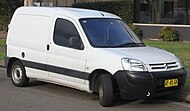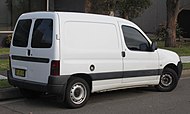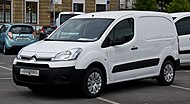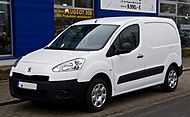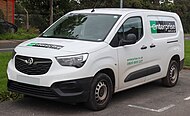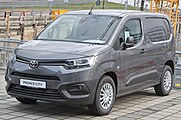The Citroën Berlingo and Peugeot Partner are a range of vans produced since 1996 and marketed under the Citroën and Peugeot marques. They are sold as light commercial vehicles or as a passenger multi-purpose-vehicle variant with rear seats and windows. They were initially a product of the French PSA Group, which later became part of the multinational Stellantis conglomerate. The third generation has also been sold under the Opel and Vauxhall Motors marques as the Combo, by Toyota as the Proace City from 2019, and by Fiat as the Doblò from 2022.
| Citroën Berlingo | |
|---|---|
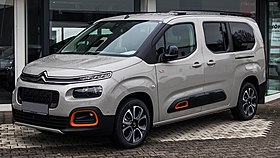 2020 Citroën Berlingo XL | |
| Overview | |
| Manufacturer | PSA Group (1996–2021) Stellantis (2021–present) |
| Production | 1996–present |
| Assembly | Villa Bosch, Argentina (Sevel) Poissy, France (PSA Poissy Plant) Casablanca, Morocco (Somaca Casablanca Plant)[1] Mangualde, Portugal (PSA Mangualde Plant) Vigo, Spain (PSA Vigo Plant) Akçalar, Turkey (Karsan)[2][3] Barra de Carrasco, Uruguay (Oferol, Grand Berlingo) Nysa, Poland (FSO) Kaluga, Russia (PCMA Rus) Kostanay, Kazakhstan (Saryarka AvtoProm)[4] |
| Body and chassis | |
| Class | Van Panel van Pickup truck (Partner II) |
| Body style | 4/5-door panel van 5-door multi-purpose vehicle 2-door pickup truck (Partner II) |
| Layout | Front-engine, front-wheel-drive |
| Chronology | |
| Predecessor | Citroën C15 Peugeot 205 Panel Van Peugeot 305 Panel Van Opel/Vauxhall Combo |
The panel vans are available in passenger versions named the Berlingo Multispace and Partner Combi, Partner Tepee, and Peugeot Rifter for the third generation. In Italy, the first generation of the Partner was known as the Peugeot Ranch. They were initially based on the Citroën ZX/Peugeot 306 estate floorpan and mechanicals.
With their rectangular, box-like cargo space and aerodynamic front, conceptually they can be considered the descendants of the Citroën 2CV panel van (AK400). The new 2018 Citroën Berlingo and Peugeot Partner/Rifter also share their design with the new Vauxhall/Opel Combo, following GM's sale of Opel to PSA.
Both the Berlingo and Partner have been produced in CNG and electric versions and with four-cylinder petrol and diesel engines.
First generation (M49; 1996)
| First generation | |
|---|---|
 | |
| Overview | |
| Also called | Peugeot Partner Peugeot Grand Raid (Mexico) Peugeot Ranch (Italy) Doninvest Orion M (Russia) |
| Production | 1996–2008 (Original versions, including Multispace) 2008–2013 (Peugeot Partner Origin, and Citroën Berlingo First) 1998–present (Argentina) |
| Model years | 1997–2013 1998–present (Argentina) |
| Body and chassis | |
| Body style | 4/5-door panel van 5-door passenger van |
| Powertrain | |
| Engine | Petrol: 1.4 L TU3 I4 1.6 L TU5 I4 1.8 L XU7 JB / LFX I4 Diesel: 1.6 L DV6 I4 HDi 1.9 L DW8 I4 2.0 L DW10 HDi |
| Electric motor | 28 kW Leroy Somer Permanent Magnet Synchronous Motor (Berlingo Electrique) |
| Transmission | 5-speed manual |
| Battery | 162 V Saft NiCd battery |
| Dimensions | |
| Wheelbase | 2,695 mm (106.1 in) |
| Length | 4,135 mm (162.8 in) |
| Width | 1,820 mm (72 in) |
| Height | 1,725 mm (67.9 in) |
The Berlingo/Partner was officially launched in July 1996.[5]
When the Berlingo was first shown at the Mondial de l'Automobile (Paris Motor Show) in 1996, a set of three concept cars was also presented:
- Berlingo Coupé de Plage
- Berlingo Berline Bulle
- Berlingo Grand Large
The Berline Bulle concept was a roomy small car, that could be considered as a precursor for the C3. Only one of these concepts was actually developed, the Grand Large version, which was developed into the Multispace and Combi people carriers/leisure vans.
Until 2010, the pre-facelift models were still produced in Argentina. The updated model finally arrived this year.[6]
- Pre-facelift Citroën Berlingo
- Pre-facelift Citroën Berlingo Multispace
- Pre-facelift Citroën Berlingo Multispace
- Pre-facelift Peugeot Partner van
- Pre-facelift Peugeot Partner van (Rear)
Facelift (M59; 2002)
A revised version, featuring a new instrument cluster, as seen in the Peugeot 206, redesigned interior and front end, was released in September 2002 (Berlingo I / Partner I).
During 2004, there was a minor facelift, including changes to the grille and light clusters.
After the launch of the second generation Berlingo and Rifter, the first generation models stayed offered. They took the names "Citroën Berlingo First" and "Peugeot Partner Origin".
In 2010, the Citroën Berlingo First Electrique and the Peugeot Partner Origin Electric were launched. These two electric vans were powered by the Monégasque firm Venturi, which assembled them in Solesmes, Sarthe.[7]
In Argentina, Peugeot launched an off-road version of its Partner, called Partner Patagónica. This model had various names when it was sold across Europe in the 2000s, including Partner Ushuaïa Grand Raid, Partner Escapade, Partner Grande Escapade, Partner VTC, Partner Indiana, and others.
From 2013, the Berlingo and the Partner were discontinued in Europe. Both LCV and passenger versions continued their career in South America, where they are still produced years after.[8]
Passenger vans Berlingo Multispace and Partner Patagónica received an update in June 2021. More parts of both vehicles are now manufactured locally. It means they now have barn doors (already manufactured locally for LCV Berlingo and Partner), replacing their tailgate that was imported from Europe.[9][10]
The Berlingo and the Partner got a minor facelift in January 2023. The Berlingo adopted an updated Citroën logo (until there it still used the sharp logo from before 2009) and a new grille, in plastic.[11] The Partner adopted the same grille and lost the piece of chrome around its front logo.[12]
- Facelifted Citroën Berlingo (2004–2012)
- Facelifted Citroën Berlingo (2004–2012)
- Citroën Berlingo Dangel (facelift, passenger model)
- Facelifted Peugeot Partner (2004–2012)
- Facelifted Peugeot Partner (2004–2012)
- Peugeot Partner Indiana (facelift)
- Interior
Engines
The vans were designed to be powered by petrol, diesel, electric, or CNG.
| Capacity | Engine | Power | Torque |
|---|---|---|---|
| 1.4 L (1360 cc) | TU3 I4 | 55 kW (75 PS; 74 hp) | 121 N⋅m (89 lb⋅ft) |
| 1.4 L GNV (1360 cc) | TU3 I4 | 55 kW (75 PS; 74 hp) | 121 N⋅m (89 lb⋅ft) CNG/Gasoline |
| 1.6 L (1560 cc) | DV6 HDi I4 | 55 kW (75 PS; 74 hp) – 68 kW (92 PS; 91 hp) | 169 N⋅m (125 lb⋅ft) – 216 N⋅m (159 lb⋅ft) |
| 1.6 L (1587 cc) | TU5 I4 | 80 kW (109 PS; 107 hp) | 147 N⋅m (108 lb⋅ft) |
| 1.8 L (1761 cc) | XU7 petrol injection I4 | 66 kW (90 PS; 89 hp) | 147 N⋅m (108 lb⋅ft) |
| 1.9 L (1905 cc) | XUD IDI diesel I4 | 52 kW (71 PS; 70 hp) | 120 N⋅m (89 lb⋅ft) |
| 1.9 L (1868 cc) | DW8 diesel I4 | 52 kW (71 PS; 70 hp) | 127 N⋅m (94 lb⋅ft) |
| 2.0 L (1997 cc) | DW10 HDi I4 | 66 kW (90 PS; 89 hp) | 205 N⋅m (151 lb⋅ft) |
| N/A | Electrique | 28 kW (38 PS; 38 hp) | 180 N⋅m (133 lb⋅ft) |
Electric version
The first-generation Berlingo was available first with a nickel-cadmium battery (Citroën Berlingo Electrique) from 1998 to 2005. After that was discontinued, a small electric fleet was built for La Poste using the first-generation Berlingo chassis, equipped with a ZEBRA molten salt battery and a powertrain from Venturi Automobiles; this fleet was delivered in 2010.[13]
Second generation (B9; 2008)
| Second generation | |
|---|---|
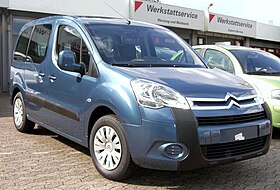 | |
| Overview | |
| Also called | Peugeot Partner Opel Combo Cargo/Life (Russia, 2021–present) |
| Production | 2008–2018 2021–present (Russia) |
| Model years | 2009–2018 |
| Body and chassis | |
| Body style | 4/5-door panel van 5-door passenger van 2-door pickup truck (Partner) |
| Platform | PSA PF2 platform |
| Powertrain | |
| Engine | Petrol: 1.6 L TU5 JP 16v I4 Diesel: 1.6 L DV6 HDi I4 |
| Electric motor | Permanent Magnet Synchronous Motor (Berlingo Electrique) |
| Transmission | 5-speed manual |
| Battery | 22.5 kW-hr lithium-ion |
| Dimensions | |
| Wheelbase | 2,728–2,730 mm (107.4–107.5 in) |
| Length | 4,379–4,628 mm (172.4–182.2 in) |
| Width | 1,810–2,112 mm (71.3–83.1 in) |
| Height | 1,805 mm (71.1 in)-1,840 mm (72 in) |
Two different models replaced the first generation of the Peugeot Partner and Citroën Berlingo in 2008, a smaller vehicle (the Citroën Nemo/Peugeot Bipper, which also replaced recently discontinued Citroën C15 First) and larger (the Citroën Berlingo II/Peugeot Partner II).
The Berlingo II, styled by Gilles Vidal, used the PSA PF2 platform (like the Citroën C4), and therefore is slightly larger, and considerably more expensive than its predecessor.
The Berlingo and Partner were officially unveiled in January 2008, with the Berlingo launched first, in the European market, in April 2008,[5] followed by the Partner in May 2008.[5] Mexico sold this generation alongside the original Partner, as do a few other countries, as the Grand Raid and Partner Origin.[citation needed]
An electric version with a traction motor and battery derived from the Mitsubishi i-MiEV was available from 2013.[14] In March 2017, a five-seater Citroen e-Berlingo Multispace was announced.[15]
- Rear view
- Citroën Berlingo (2012 facelift)
- Citroën Berlingo X-TR Multispace (2012 facelift)
- Citroën Berlingo (2015 facelift)
- Citroën Berlingo Mountain Vibe Concept
- Peugeot Partner (pre-facelift)
- Peugeot Partner Tepee (pre-facelift)
- Peugeot Partner (2012 facelift)
- Peugeot Partner Tepee (2012 facelift)
- Peugeot Partner (2015 facelift)
- Peugeot Partner Tepee (2015 facelift)
Russia


This generation is also manufactured and sold in Russia as the Peugeot Partner (and as the passenger oriented Peugeot Partner Crossway),[16] Citroën Berlingo (and Citroën Berlingo Multispace)[17] and exclusive Opel Combo Cargo (and Opel Combo Life)[18] since March 2021.
Engines
| Model | Engine | Displacement | Power | Torque | Note | CO2 emission (g/km) |
|---|---|---|---|---|---|---|
| 1.6i 16V | I4 | 1587 cc | 90 PS (66 kW; 89 hp) @5800 rpm | 132 N⋅m (97 lb⋅ft) @2500 rpm | 195 |
| Model | Engine | Displacement | Power | Torque | Note | CO2 emission (g/km) |
|---|---|---|---|---|---|---|
| 1.6HDi 16V | I4 | 1560 cc | 75 PS (55 kW; 74 hp) @4000 rpm | 185 N⋅m (136 lb⋅ft) @1750 rpm | 149 | |
| 1.6HDi 16V | I4 | 1560 cc | 90 PS (66 kW; 89 hp) @4000 rpm | 215 N⋅m (159 lb⋅ft) @1750 rpm | 149 | |
| 1.6HDi 16V | I4 | 1560 cc | 110 PS (81 kW; 108 hp) @4000 rpm | 240 N⋅m (177 lb⋅ft) @1750 rpm | 140 | |
| 1.6 BlueHDi 8V | I4 | 1560 cc | 75 PS (55 kW; 74 hp) | BVM5 | 113 | |
| 1.6 BlueHDi 8V | I4 | 1560 cc | 100 PS (74 kW; 99 hp) | BVM5 | 113 | |
| 1.6 BlueHDi 8V | I4 | 1560 cc | 120 PS (88 kW; 118 hp) | 300 N⋅m (221 lbf⋅ft) | BVM6 | 113 |
| Model | Engine | Power | Torque | Note | CO2 emission (g/km) |
|---|---|---|---|---|---|
| Berlingo Electric | 49 kW (66 hp; 67 PS) | 200 N⋅m (148 lb⋅ft) | 0 |
Third generation (K9; 2018)
| Third generation | |
|---|---|
 Citroën Berlingo | |
| Overview | |
| Model code | K9 / EK9[19] |
| Also called |
|
| Production | 2018–present |
| Assembly |
|
| Body and chassis | |
| Body style | 4/5-door panel van 5-door passenger van |
| Platform | PSA EMP2 |
| Powertrain | |
| Engine |
|
| Electric motor | 136 PS (100 kW; 134 hp) PMSM (electric versions) |
| Transmission | 5-6-speed manual 8-speed automatic EAT8 |
| Battery | 50 kWh lithium-ion (electric versions) |
| Electric range | 330km WLTP (Toyota Proace City Electric) |
| Dimensions | |
| Wheelbase | 2,785–2,975 mm (109.6–117.1 in) |
| Length | 4,403–4,753 mm (173.3–187.1 in) |
| Width | 1,848 mm (72.8 in) |
| Height | 1,796–1,860 mm (70.7–73.2 in) |
The third generation Berlingo and a new Peugeot Rifter was officially unveiled at the 2018 Geneva Auto Show. The model is also sold as the fourth generation Opel and Vauxhall Combo after the PSA Group bought Opel in March 2017 and, from the end of 2019, as the Toyota Proace City, following the extension of the partnership in utility vehicles between PSA and Toyota. The Proace City was officially unveiled at the 2019 Commercial Vehicle Show in Birmingham.[22][23] The Fiat-badged version was released as the Fiat Doblò in June 2022 in both ICE and e-Doblò electric version.[24]
The third generation Berlingo is the first of the nameplate to be launched in Japan, in October 2019.[25]
In January 2022, Stellantis stops marketing the internal combustion versions (diesel and gasoline) of its passenger vans in United Kingdom, Norway and European Union countries.[26] This decision is motivated by a decision to reduce the average CO2 emissions of vehicles marketed by the company in Europe in accordance with EU regulations on emissions. As a result, the Berlingo, Rifter and Combo Life are now only offered in their battery electric version. Panel vans are not affected by this change, nor are Toyota-badged models, as the Japanese manufacturer is in line with the objectives of the CAFE regulations. The internal combustion variants of the Stellantis passenger vans are expected to return in 2023 with a mild-hybrid system.[27]
Electric versions
On 14 January 2021, Citroën unveiled the electric ë-Berlingo Van,[28] which was followed 6 days later by the Opel Combo-e Cargo and the Vauxhall Combo-e,[29][30] and again 6 days later by the Peugeot e-Partner.[31] On 26 February 2021 Peugeot introduced e-Rifter,[32] and on 4 May 2021, Toyota unveiled Proace City Electric and Proace City Verso Electric.[33]
In 2023, production began at the Ellesmere Port factory.[34]
Variants
Caselani Fourgonnette
Inspired by the 1951 Citroën 2CV Fourgonnette, it is a retro-bodied Berlingo coach-built by the Italian firm Caselani, with production of the 200 units starting on 1 October 2022.[35][36] It was unveiled at the 2022 Paris Motor Show.[37]
Commercial versions
- Citroën Berlingo van, note that it has a different front end design than the passenger version
- Citroën Berlingo van (rear)
- Fiat Doblò
- Peugeot Partner
- Vauxhall Combo
- Toyota Proace City
Passenger versions
- Citroën Berlingo
- Citroën Berlingo XL
- Citroën Berlingo XL
- Citroën ë-Berlingo
- Fiat E-Doblò
- Peugeot Rifter
- Opel Combo Life
- Vauxhall Combo Life
- Toyota Proace City Verso
- Interior (Peugeot Rifter) with the Peugeot iCockpit design
- Interior (Citroën Berlingo)
- Interior (Opel Combo Life)
Facelift
A facelift was revealed on 23 October 2023, introducing technological updates.[38][39] Mild hybrid combustion models are launched with the passenger variants on all markets, after a brief hiatus.[40]
- Citroën Berlingo (facelift)
- Fiat Doblò (facelift)
- Opel Combo (facelift)
- Peugeot Rifter (facelift)
- Toyota Proace City (facelift)
- Toyota Proace City Verso (facelift)
Worldwide sales and production
| Year | Worldwide production | Worldwide sales | Notes | ||
| Berlingo | Partner | Berlingo | Partner | ||
| 2008 | TBA | TBA | TBA | 147,600[41] | |
| 2009 | TBA | 120,500[42] | TBA | 133,300[41] | |
| 2010 | TBA | 164,600[42] | TBA | 160,200[42] | |
| 2011 | 164,162[5] | 167,368[5] | 165,807[5] | 165,240[5] | Total Berlingo production reached 2,448,214 units. Total Partner production reached 1,964,054 units.[5] |
| 2012 | 136,800[43] | 142,300[43] | 139,800[43] | 149,800[43] | Total Berlingo production reached 2,585,000 units. Total Partner production reached 2,106,300 units.[43] |
See also
References
External links
Wikiwand in your browser!
Seamless Wikipedia browsing. On steroids.
Every time you click a link to Wikipedia, Wiktionary or Wikiquote in your browser's search results, it will show the modern Wikiwand interface.
Wikiwand extension is a five stars, simple, with minimum permission required to keep your browsing private, safe and transparent.





